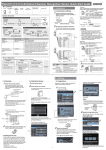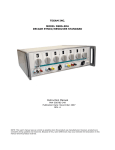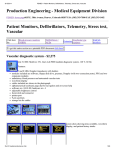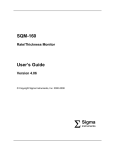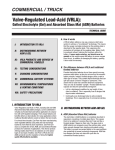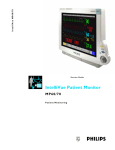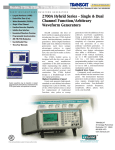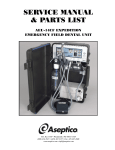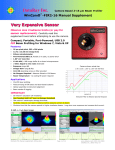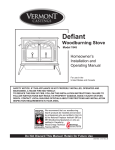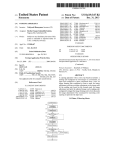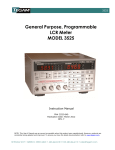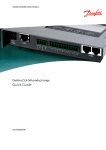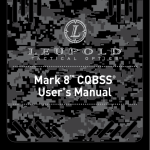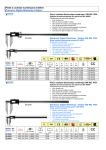Download TEGAM INC. MODEL M-1011A and M
Transcript
TEGAM INC. MODEL M-1011A and M-1012A AC RATIO STANDARD Instruction Manual PN# M-1011A-840-01 Publication Date: June 2008 REV. A TEGAM INC. MODEL M-1011A and M-1012A AC RATIO STANDARD Instruction Manual PN# M-1011A-840-01 Publication Date: June 2008 REV. A NOTE: This user’s manual was as current as possible when this product was manufactured. However, products are constantly being updated and improved. Because of this, some differences may occur between the description in this manual and the product received. Figure 1-1. Model M-1011A or M-1012A AC Ratio Standard 1-0 15 1 2 14 13 3 12 4 11 5 10 17 6 7 9 8 18 16 19 20 26 21 25 24 23 22 Figure 3-1. Operating Controls, Switches, and Terminals, Model M-1011A or M-1012A 3-0 Section III CONTROLS, SWITCHES, AND TERMINALS 3.1 INTRODUCTION This section contains functional descriptions of all Model M-1011A and Model M-1012A controls, switches, and terminals. The location and purpose of the controls, switches and terminals are the same for the two AC ratio standard instruments. 3.2 CONTROLS, SWITCHES, AND TERMINALS All external controls, switches, and terminals of the Model M-1011A and M-1012A are located on the front and back panels. Their location is identified by numbers in Figure 3-1, and their function described in Table 3-1. Table 3-1. Controls, Switches, and Terminals 1 PANEL/DIAL MARKING 0 TO X REFERENCE DESIGNATOR S1 2 -1 TO X S2 3 -1 TO X S3 KEY FUNCTION Decade switch that provides 1 X 10-1 voltage ratio steps from 0 to 10 X 10-1 (x) (11 positions). Decade switch that provides 1 x 10-2 voltage ratio steps from -1 to 10 x 10-2 (x) (12 positions). Decade switch that provides 1 x 10-3 voltage ratio steps from 1 to 10 x 10-3 (x) (12 positions). 3-1 Section IV INSTALLATION 4.1 UNPACKING No special handling or unpacking procedures are required. After unpacking, inspect units for any evidence of damage. 4.2 BENCH OPERATION The AC ratio standard is shipped ready for use as a bench-operated instrument. A folding support that is attached to the feet under the front of the instrument may be pulled down to elevate the front of the instrument for ease of operation. 4.3 RACK MOUNTING Rack mounting, option 11, (TEGAM part number OPT-11) is available at extra cost. Option 11 consists of a set of adapter brackets and attaching screws that permits mounting the AC ratio standard into a standard 19 inch rack. To prepare the instrument for rack mounting, proceed as follows: 4.4 a. Remove the six screws that attach the four feet and folding support to the bottom of the instrument. Retain the screws, feet and support for future use. b. Attach one rack mounting bracket (Part No. 964729-003-1) to each side of the instrument using two 10-32 X 3/8” flat head screws (Part No. 964064-263) and three 6-32 x 3/8” flat head screws (Part No. 964064-028) in each bracket. Note that you will need to remove the two 6-32 screws securing the side frame to the front panel to install the new 6-32x3/8” flat head screw. OPERATING POWER No operating power is required, however, excitation voltage is required during operation, refer to Tables 2-1 and 2-2. 4-1/4-2 Section V OPERATION 5.1 INTRODUCTION Instructions for operating the AC ratio standard models are presented in this section. Refer to Section III for descriptions of the operating controls, switches, and terminals. Refer to Section IV for installation information. 5.2 CONNECTING TO THE AC RATIO STANDARD Three output circuit configurations are available to the user. All configurations have the same direct input connection and provide in-phase output voltage. Choice of output circuit is controlled by which terminals are used. Refer to Figure 5-1 for abbreviated schematics of the three Ratio Standard configurations. 5.3 OPERATION 5.3.1 General A typical application of the Ratio Standard is shown in Figure 5-2. The output of the Ratio Standard is compared to the output of the unit under test using a phase-sensitive null indicator such as a phase angle voltmeter, TEGAM Model PAV-4. When the in-phase components of the two outputs are exactly equal, the phase angle voltmeter indicates a null. The input-to-output voltage ratio of the unit under test may then be read from the settings of the Ratio Standard. Additional applications are available from the factory. 5-1 CAUTION Make certain the input voltage does not contain a dc component. DC currents of more than a few microamperes will cause saturation of the input winding. If dc voltage is accidentally applied to the unit, degauss the unit as outlined in the maintenance section, Paragraph 7.3. c. Make connections to the OUTPUT and COMMON terminals. Refer to Figure 5-1, “Standard Configuration”. CAUTION Do not apply voltage across the output terminals. d. Turn the input voltage source ON. e. Set the standard controls to the desired ratio or to the setting required to obtain a null. When a null has been obtained, the FUSE toggle switch may be thrown to the OUT position to provide a more accurate null measurement. f. When a final null is obtained, the input-to-output voltage ratio of the unit under test may then be read from the switch settings of the standard. CAUTION After the ratio reading has been recorded, the FUSE toggle switch should be returned to the IN position for input circuit protection. 5-4 Section VI THEORY OF OPERATION 6.1 GENERAL The AC Ratio Standard consists of seven tapped transformer windings and seven rotary switches. Refer to the Schematic Diagram, Figure 9-1. A portion of the input voltage is selected from each tapped winding and these portions are added together to form the output voltage. The full input voltage is applied across the INPUT and COMMON terminals and thus across the decade portion of the input (10-1) winding. The 10-1 winding and each of the remaining windings (10-2 through 10-7) are precisely tapped to provide 12 equal subwindings that will provide 12 precise voltage outputs. S1 has eleven positions. The lower wiper arm of S1 can select any of eleven voltages from 0 to 1.0 volts in precise 0.1 input voltage ratio steps. The two wiper arms of switch S1, separated by one position, applies precise 0.1 voltage portions of the 10-1 winding across the decade portion of the 10-2 winding. The lower wiper arm of S2, which has 12 positions, selects a -0.01 to 0.1 portion of the input voltage selected by switch S1. The process continues through the seven windings until the final and smallest portion is selected by switch S7. The input winding between the INPUT terminal and the 1.1 terminal provides a precise 0.1 step-up on the input voltage. The total voltage between the 1.1 terminal and the COMMON terminal is precisely 1.1 times the input voltage. The input winding between the COMMON terminal and the -.1 terminal supplies a voltage with an amplitude precisely 0.1 times the input voltage and 180 degrees out of phase. The voltage between the COMMON terminal and the -.1 terminal is therefore -0.1 times the input voltage. 6-1 The seven transformer windings are included in two transformers. The first transformer (T1) contains three windings (10-1, 10-2, and 10-3) on a common toroid core. The second transformer (T2) contains three windings (10-4, 10-5, and 10-6) on one common core and the final 10-7 winding on a separate core. Switching transients are virtually eliminated by resistors R1, R3, R5, R7, R9 and R11 (Model M-1011A), and R1 through R20 (Model M-1012A), which maintain continuity between voltage steps while settings are being changed. The switch contacts are multileaf type that have very low contact resistance. Additionally, each switch has four decks that are paired and wired in parallel to further reduce contact resistance. 6.2 THEORETICAL ANALYSIS OF ACCURACY Theoretical analysis of a perfect autotransformer used for stepdown purposes shows that if leakage inductances and winding resistance are uniformly distributed and the turns can be accurately tapped, the accuracy as a voltage divider for no load is perfect. Consider first the effects of leakage inductance. The most symmetrical configuration in so far as flux is concerned, is the uniformly wound toroid. By suitably interleaving the windings and carefully maintaining uniformity, the total leakage inductances can be kept to under 10% of the air core inductance. Since the air core inductance is approximately 1/μ times the inductance with iron core, where μ is the permeability of the core material, the total leakage inductance to coupled inductance ratio is 1/10μ. The core material used in the transformers is supermalloy which has a guaranteed initial permeability of 100,000. The leakage to coupled inductance ratio is therefore approximately .0001%. Since this figure represents the ratio of voltage dropped in the leakage inductance to total voltage, the error in the transformer due to non-distributed leakage inductance will not exceed this, if the leakage inductance per turn does not vary by more than ±100%. This condition can be met with suitable techniques of interleaving the windings. 6-2 Non-distributed winding resistance has much the same effect as nondistributed leakage inductance. If the effects of winding capacities are neglected, the winding resistance is most important at low frequencies since the exciting impedance of the transformer is directly proportional to frequency. Since the exciting impedance is fairly reactive, the voltage dropped in the winding resistance will be almost in quadrature with the input and consequently any non-distributed resistance will cause some phase error as well as magnitude error. The fact that this error voltage is in quadrature makes the magnitude error extremely small and for all practical purposes negligible. Typical figures might be .000001% for small ratios and even less for larger ratios. Phase angles from this cause would be approximately .01 milliradians at low frequencies and small ratios, decreasing for larger ratios. At higher frequencies distributed capacitance becomes important. It causes voltage drops in the leakage inductance and winding resistance which are not uniformly distributed due to the transformer action. Like the effects of winding resistance, the errors caused by the capacitance are mainly in quadrature and so cause phase shift at low ratios. Typical values for this phase shift are: Less than .05 milliradians for frequencies below 1 kHz and Ratios above .1 for low voltage – high frequency units. Less than .05 milliradians for frequencies below 200 Hz and ratios above .1 for high voltage low frequency units. Phase angle due to this cause is almost directly proportional to frequency for any particular ratio down to frequencies where the non-distributed resistance takes over. Another source of error is voltage drop due to exciting current in the leads to the transformer. This effect may be minimized by using heavy connecting leads or treating the transformer as a four terminal impedance. The internal wiring of the transformers contributes to this error. These effects are worst at higher frequencies, above the self-resonant frequencies of the transformers. 6-3 Section VII MAINTENANCE 7.1 GENERAL Since AC Ratio Standards are passive devices, a minimum maintenance is required. With the exception of cleaning switch contacts, no maintenance on a regularly scheduled basis is required. Moving parts are lubricated at the factory and should require no further lubrication. 7.2 SWITCH CONTACTS During Calibration Intervals, clean switch contacts with a good grade of solvent such as alcohol or acetone. Relubricate contacts with a small amount of light lubricant. 7.3 DEGAUSSING If dc voltage is accidently applied to the input terminals, degauss the unit as follows: a. Connect a 1K resistor in series with the INPUT terminal. b. By means of a variac or other suitable voltage control, apply a 60 Hz signal between the open end of the 1K resistor and the COM terminal. c. Starting with the voltage control at zero, increase voltage to 40 V rms. d. Slowly decrease the voltage to zero. The period of time to reduce the voltage from 40 V rms to zero should be between 10 to 15 seconds. 7-1 S106 S105 S104 S103 S102 S107 S101 T102 T101 NOTE: The Model M-1012A is the same except for the size of T1 and T2 and the model number. Figure 7-1. Location Of Components, Model M-1011A (Top View) 7-2 7.4 CALIBRATION CHECK Provided that the AC Ratio Standard is kept in a normal laboratory environment, the unit should only require a calibration check every three years. Under more severe conditions, the calibration period must be shortened. This section includes two tests: an input impedance test and a simplified ratio accuracy test. Refer to Table 7-1 for a list of test equipment required. Table 7-1 Test Equipment Required NOMENCLATURE PART NUMBER OR MODEL AC Ratio Standard Model M-1011A or Model M1012A Bridge Transformer Null Indicator Model ST248 (TEGAM) Model PAV-4 or equivalent Decade Resistance Box DVM Switch Audio Oscillator APPLICATION Provides comparison standard for ratio test. Provides signal isolation. Provides means of comparing output voltage. Provides voltage divider network. Measuring voltages Check voltage divider network. AC Voltage Source RANGE 1.111111 to -0.111111 ratios ACCURACY Per National Institute of Standards Calibration Test 120 Vac, 400 cps (maximum) 1 megohm range ±0.5% 2% SPDT 20 Hz to 20KHz 0 to 45 VRMS 7-3 7.4.2 Ratio Accuracy Test This procedure uses a Model M-1011A or M-1012A AC Ratio Standard as a reference. To test the ratio accuracy proceed as follows: a. Use test setup shown in Figure 7-3. b. Set input signal frequency to 400 Hz. c. Apply an input voltage of 10 V AC as indicated on Voltmeter V1. d. Set the Model M-1011A or M-1012A AC Ratio Standard reference controls for an output reading of 0.0000000. e. Adjust unit under test controls until the Null Indicator indicates a null. f. Compare the ratio indicated by the unit under test against the ratio indicated by the reference standard. The two ratios shall agree within the “Accuracy of Indicated Ratio” listed in Table 2-1. g. Repeat steps “e” through “f” for each switch position of the reference Standard (0.1111111, 0.2222222, etc.). 7-5 Section VIII REPLACEABLE PARTS 8.1 INTRODUCTION This section includes all pertinent data necessary to locate, identify, and procure additional parts for the equipment. Parts are listed alphanumerically by reference symbol and include all replaceable electronic items. Satisfactory replacement may be made with either the listed component or an exact replacement of the parts (s) removed from the equipment. 8.2 ORDERING INFORMATION The following instructions will aid in ordering parts: a. Address all inquires or orders to: CUSTOMER SERVICE DEPARTMENT TEGAM, Inc. 10 Tegam Way, Geneva, Ohio 44041 b. Include the following information: 1. Model and Serial Number of instrument. 2. Assembly Reference Symbol Number (i.e. A1A1). 3. Reference Designation Number (i.e. C1). 4. TEGAM Part Number. 5. Description (as shown on Parts List). c. Packing No special handling or packing procedures are required. It is suggested you pack the instrument in a crash resistant box. 8-1 8.3 PARTS LIST USE The Table of Contents at the front of the manual lists the Parts List Tables, related assemblies, and location. The following paragraphs describe the use and meaning of the four columns included in the Parts List starting with Table 8-3. a. Reference Designation, Column 1 The Reference Designation column contains an alpha-numeric listing of parts as they appear on the equipment chassis, illustration, or schematic. The reference designation identifies the parts as to their component function in the instrument. Refer to Table 8-1. b. TEGAM Part Number, Column 2 The TEGAM Part Number column contains the part number as designated by TEGAM. c. Description, Column 3 The Description column contains the identification of component parts, including all pertinent specifications. When the description column is used for a reference symbol for which no part exists, “NOT USED”, is placed in the column. In these instances, column 2 is left blank. Refer to Table 8-2 on abbreviations that are used in the Parts List. d. Total Quantity, Column 4 The total quantity used of each Part Number listed. 8-2 TABLE 8-1. Reference Symbols A C F K L Assembly Capacitor Fuse Relay Inductor R S T W XF Resistor Switch Transformer Cable Fuse Holder TABLE 8-2. Abbreviations A AC Desig. Hz k Mfr Ampere Alternating Current Designator Hertz Thousand (103) Manufacturer mH No. Ref. V W % Millihenry Number Reference Volts Watts ±% if sign not shown 8-3 TABLE 8-3. Parts List for Model M-1011A Ref. Desig. F1, F2 XF1, XF2 S8 TEGAM Part No. 104561-001 203052-001 203076-001 203077-001 203078-001 203192-001 404444-001 404499-001 966050-001 964003-028 964003-045 964006-005 964025-005 964025-006 964064-028 964066-004 964066-005 6093-001 100564-001 203040-001 924000-022 924001-001 941018-001 941018-002 941018-003 951036-027 6113-002 203079-001 964003-028 964003-029 964024-005 Description Bezel Chassis Bracket, Cover Cover, Slide Cover, Top Trim Dial Knob Frame, Side Screw, Mach. PH 6-63X3/8 Screw, Mach. PH 8-32X1/2 Hex Nut 6-32 Washer .312 OD Washer .375 Screw, Mach. 6-32x3/8 Washer, Lock #6 Washer, Lock #8 Rear Panel Sub. Assy. Washer Rear Panel Fuse, 1.5 amphere Fuse Holder Binding Post, Red Binding Post, White Binding Post, Black Toggle Switch Bottom Cover Assy. Bottom Cover Screw, Mach. PH 6-32x3/8 Screw, Mach. PH 6-32x7/16 Screw, Mach. FH 4-40x7/16 Total Qty. 2 1 2 2 1 2 7 7 2 4 8 3 7 8 26 7 8 1 2 1 2 2 4 2 2 1 1 1 2 4 6 8-4 TABLE 8-3. Parts List for Model M-1011A (continued) Ref. Desig. T1 T2 S1 thru S7 R5, R7 R9, R11 R1, R3 TEGAM Part No. 964025-005 964066-004 964118-104 006148-001 1985-002 1986-002 203044-001 402180-001 945001-021 945001-041 964005-009 964006-011 6115-001 100564-001 104556-001 203002-001 203053-001 941018-001 941018-002 941018-003 964006-006 964025-006 964066-005 Description Washer Flat .312 ID Washer, Spring Lock #6 Tilt Bail Switch Sub. Assy. Transformer, Toroid Transformer, Toroid Switch Bracket Rotary Switch Resistor, Composition 47 ohms, 10%, 1/2W Resistor, Composition 2.2K ohms, 10%, 1/2W Lockwasher 3/8 Int. Tooth Hex Nut 3/8-32 Front Panel Assy. Washer Front Panel Bracket Window Binding Post, Red Binding Post, White Binding Post, Black Hex Nut 8-32 Washer, Flat .375OD Washer, Spring Lock #8 Total Qty. 6 6 1 1 1 1 1 7 4 2 7 7 1 2 1 2 7 4 2 2 4 4 4 8-5 TABLE 8-4. Parts List for Model M-1012A Ref. Desig. F1, F2 XF1, XF2 S8 TEGAM Part No. 104561-001 203052-001 203076-001 203077-001 203078-001 203192-001 404444-001 404499-001 966050-001 964003-028 964003-045 964006-005 964025-005 964025-006 964064-028 964066-004 964066-005 6093-001 100564-001 203040-001 924000-022 924001-001 941018-001 941018-002 941018-003 951036-027 6113-002 203079-001 964003-028 964003-029 964024-005 Description Bezel Chassis Bracket, Cover Cover, Slide Cover, Top Trim Dial Knob Frame, Side Screw, Mach. PH 6-63X3/8 Screw, Mach. PH 8-32X1/2 Hex Nut 6-32 Washer .312 OD Washer .375 Screw, Mach. 6-32x3/8 Washer, Lock #6 Washer, Lock #8 Rear Panel Sub. Assy. Washer Rear Panel Fuse, 1.5 amphere Fuse Holder Binding Post, Red Binding Post, White Binding Post, Black Toggle Switch Bottom Cover Assy. Bottom Cover Screw, Mach. PH 6-32x3/8 Screw, Mach. PH 6-32x7/16 Screw, Mach. FH 4-40x7/16 Total Qty. 2 1 2 2 1 2 7 7 2 4 8 3 7 8 26 7 8 1 2 1 2 2 4 2 2 1 1 1 2 4 6 8-6 TABLE 8-4. Parts List for Model M-1012A (continued) Ref. Desig. T1 T2 S1 thru S7 R5, R7 R9, R11 R1, R3 TEGAM Part No. 964025-005 964066-004 964118-104 006144-001 1859-001 1860-001 203044-001 402180-001 945001-021 945001-041 964005-009 964006-011 M-1012A-051 100564-001 M-1012A-330 203002-001 203053-001 941018-001 941018-002 941018-003 964006-006 964025-006 964066-005 Description Washer Flat .312 ID Washer, Spring Lock #6 Tilt Bail Switch Sub. Assy. Transformer, Toroid Transformer, Toroid Switch Bracket Rotary Switch Resistor, Composition 47 ohms, 10%, 1/2W Resistor, Composition 2.2K ohms, 10%, 1/2W Lockwasher 3/8 Int. Tooth Hex Nut 3/8-32 Front Panel Assy. Washer Front Panel Bracket Window Binding Post, Red Binding Post, White Binding Post, Black Hex Nut 8-32 Washer, Flat .375 OD Washer, Spring Lock #8 Total Qty. 6 6 1 1 1 1 1 7 4 2 2 7 1 2 1 2 7 4 2 2 4 4 4 8-7 Section IX SCHEMATIC DIAGRAMS 9.1 INTRODUCTION Section IX contains a Schematic Diagram for the Models M-1011A and M-1012A AC Ratio Standard instruments. 9-1/9-2










































